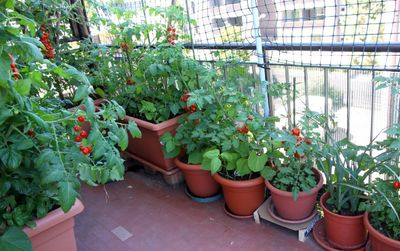Apartment Gardening Ideas Outdoors
Outdoor container gardens for apartment dwellers is much easier if you use self-watering containers with reservoirs that hold enough water to keep the soil moist without constant attention. Outdoor containers, particularly those in full sun, dry out quickly on hot days and may need watering more than once a day in the heat of summer. With a self-watering container, you don’t have to arrange your life around a watering schedule. Patios and balconies are ideal places for plants. Before you buy your plants, watch to see how much sun your space receives. Eight hours of direct sunlight per day is considered full sun. Four to six hours is partial shade and less than four hours is shade. Evaluate the space in spring or summer after all the surrounding trees and shrubs are in full leaf and choose plants appropriate for the amount of light available. Do you use your outdoor space more in the daytime or at night? White and pastel flowers show best at night, while deep blues and purples need sunlight to show off their colors. If you enjoy a relaxing evening outdoors, consider growing plants that release their fragrance at night, such as nicotiana and moonflower. For small spaces, choose plants that grow up rather than out. Bushy shrubs can soften the appearance of the patio, but they take up a lot of space. Choose columnar or pyramidal plants for tight spaces. Urban gardening in apartments should be a pleasure, not a chore. If you are short of time, you’ll have lots of lovely plants to choose from that need very little attention. If you want a challenge, you’ll find plenty of plants that fill that need, too. Above all, choose plants that thrive in your apartment garden conditions, look good, fit well in the space, and appeal to you.
Apartment Gardening Guide Indoors
Learn to make the most of your indoor gardening space by choosing plants that grow well in a variety of different locations. Reserve bright windowsills for flowering plants that need lots of sun. Plants with bright or variegated foliage, such as the polka dot plant and croton, develop the best color near a bright window but out of direct light. Peace lilies and cast iron plants are noted for their ability to thrive in dim corners and recesses of your apartment. Small potted plants look more appealing in groups. Placing them in small clusters raises the humidity in the surrounding air and results in healthier plants. Hanging baskets are a great way to display trailing plants and it leaves tabletops for plants that are best seen at or below eye level. Small trees add tranquility and tropical appeal to an indoor setting. Keep in mind that palms can’t be pruned back. Palms grow slowly and if you choose small specimens, you’ll save money and enjoy them for several years. Indoor fruit trees and flowering trees need long periods of bright sunlight every day. Filling your indoor space with plants creates a relaxing environment and helps purify the air. Peace lilies, pothos, and English ivy are among the easiest plants to grow and NASA studies have shown that they filter toxins such as ammonia, formaldehyde, and benzene from the air. Other good plants that improve air quality include date palms, rubber plants, and weeping figs.
